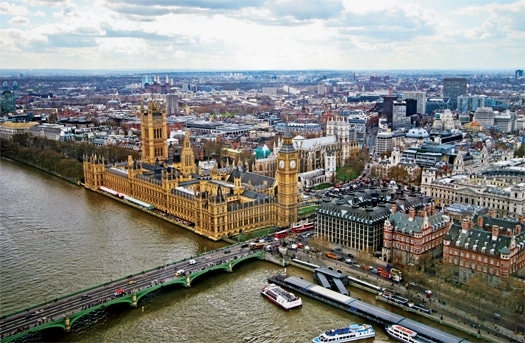
ytgjul14london525.jpg
St. Katharine Docks in London was an experience not to be missed, a longtime goal of ours has been to visit this historic marina on our own yacht.
A first-time visitor to this part of the world might find the charts, traffic separation schemes, and tides intimidating. Wind Horse, our FPB 83 motoryacht, is over 20 meters in length, and is therefore required to stay with commercial shipping in designated traffic separation channels. Heading up the Thames, we also need to maintain a radio watch and communicate with London Vessel Traffic Services on VHF Channel 14. Once we begin to thread our way through the approaches, we find the transit is simpler than the guides and charts suggest, and London VTS is very helpful.
There are substantial tides here that run to 20 feet during full and new moons, so marinas along the Thames are equipped with either tidal gates or sills. Since these are accessible only within an hour or two of high tide, we plan on picking up three to four knots of favorable current as we ride a rising tide up the River Thames.
Four hours and 56 miles later, we are waiting with two sailboats at the Tower Bridge, adjacent to St. Katharine Docks, for the lockmaster to open the gates. Clearing customs into the U.K. has required only a simple phone call. But as we hold station against the current, we are hailed by a Metropolitan Police launch. Two officers step aboard and politely but thoroughly question us. When they’re through, they help us with the lines in the lock, and then say goodbye. The lockmaster closes the outer gate, adjusts the water level, and then opens the inner lock and two hydraulically operated footbridges invite us to proceed to this ancient enclave.
The River Thames in the area of the Tower Bridge has been used for shipping since Roman times. King Edgar issued the first formal charter for dockage in the tenth century when he gave 13 acres to 13 knights. By the beginning of the 19th century, shipping traffic on the Thames had bottlenecked. Parliament passed the St. Katharine Docks Bill and eventually one of the largest construction projects in London history began. More than 2,500 men worked for two years on a revolutionary dock plan with three interconnected basins, and significantly more wharfage per water acre than was traditional. Now ships could moor directly alongside as small jib cranes offloaded cargo from their holds directly to the upper stories of dockside warehouses. The offloading process that formerly required a week was now done in half a day, with valuable cargoes stored in secure warehouses.
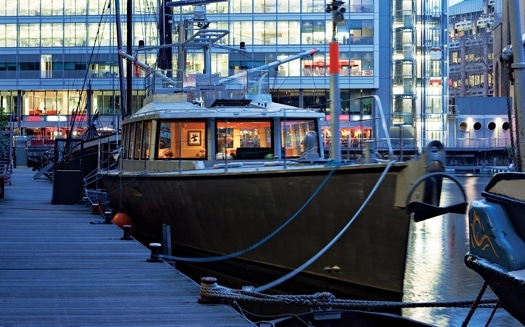
| | |
By the 1880s, London’s docks were losing out to larger facilities closer to the North Sea, and St. Katharine Docks had begun a slow decline. In the 1960s, it had become a wasteland of derelict, rat-infested buildings. Enter development company Taylor Woodrow. They offered a plan to redevelop the docks and warehouses into a mix of office, apartment, retail, and marina space. The plan took 25 years to mature, but it set the tone for similar waterfront redevelopments around the world.
It is to the west of the original three basins that Wind Horse is now headed. Despite the history of these docks, large, modern buildings surround us, sounding a distinctly urban note. A hotel to our south is an ideal place for our daughter and son-in-law to stay while we hang out with the grandkids aboard Wind Horse. An office complex is adjacent to our dock and another office building abuts the north side of our basin. To the east is Ivory House, one of the few original structures not bombed during World War II. It’s been converted to groundfloor retail spaces with condos above.
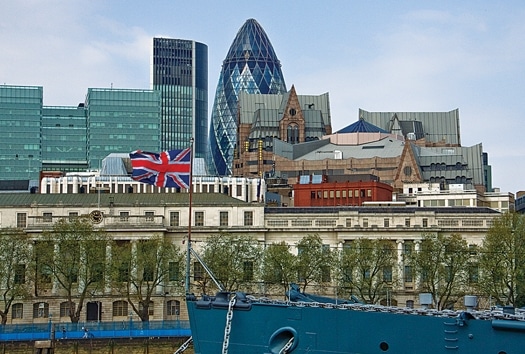
| | |
For the cruising yachtsman, there are numerous advantages to St. Katharine. To begin with, it is centrally located in the heart of London, adjacent to the “City,” as the financial district is known. We are a fiveminute walk from the Tower of London, which dates to the eleventh century and William the Conqueror. London’s famous Tube, an extensive system of subways, has a station two blocks from our dock. We can get to most of London’s museums, gardens, palaces, and other places of interest within 20 minutes.
We have a variety of marina-view restaurants from which to choose. Italian, French, Indian-even medieval banquet fare-are available. A meal with a couple of glasses of wine runs about $60. Also on-site are several coffee shops, a café, bagel shop, dry cleaners, hair salon, drug store, and newsstand. A U.S. style supermarket with everything from goose fat (for locals) to peanut butter (for visiting yachties) is close by. If your yachting wardrobe is looking a little dated, you can check out the latest fashions from bespoke to casual hip. We share the docks with a fleet of traditional Thames sailing barges and a variety of yachts from different nations, so there are always interesting boats to inspect.
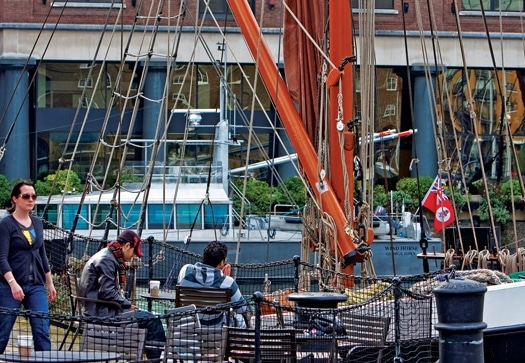
| | |
Best of all, this is a quiet area. The only traffic is on foot, as the office and apartment dwellers rush to and from the Tube station and other public transport at the beginning and end of their workdays. A security staff of retired Nepalese Gurkha troops, and a friendly marina crew headed by dockmaster Charlie Telfor, keep an eye on the slips. The marina docks, basins, and surrounding real estate are all beautifully maintained.
And there always seems to be something going on. Just this week Suhaili, the little ketch in which Robin (now Sir Robin) Knox-Johnston won the first single-handed round-the-world race is on display. There is a Clipper Round the World Race boat moored nearby, we have musical entertainment in front of one of the restaurants, and the London Marathon passed near St. Katharine Docks around the 22-mile mark.
For all the sights and sounds of modern life that surround cruising yachtsman at St. Kat’s, there’s historical ambiance galore. The floating docks are anchored to the same brick walls that sheltered 19th century clipper ships bringing tea from China and ivory from Africa. Quayside bollards and cobblestone walkways are original. The Dickens Inn, now a large eating and drinking establishment, is built within the confines of a 19th century warehouse. It is dark, lowceilinged, and very cool.
Prefer something a little older? Walk ten minutes east along the river to the Prospect of Whitby, a pub that opened its doors in 1520 and serves warm beer on the same premises where the diarist Samuel Pepys used to knock back a few. If you prefer it, more modern fare is available up the street at the upstart Town of Ramsgate, which has only been a public house since 1545.
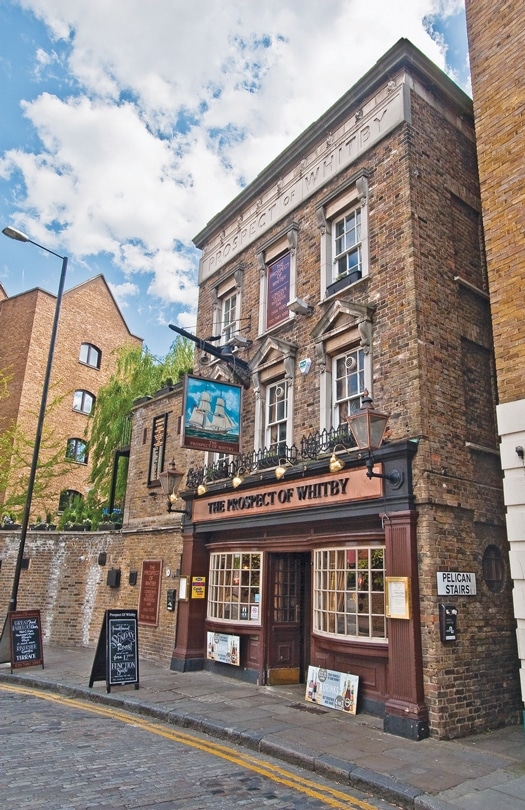
| | |
It’s the contrast between new and old that makes a stay here so extraordinary. London has some of the most avant-garde, high-rise real estate you will see anywhere in the world. Juxtaposed with the traditional buildings and detritus left by the Romans, it makes for an amazing visual experience.
We are not big-city fans. L.A. we can take for two days, New York maybe three. In cruising mode, we rarely spend more than a week in one location. But there is so much to do and see in London, and all so easily accessible by Tube, that it’s hard to break away. Museums are for the most part free, and if you are early, not too crowded. Of course, if you want to watch the changing of the guard, see the royal jewel collection in the Tower, or check out Piccadilly Circus, there are a million other tourists you’ll meet who had the same idea. You can also take in some of the many famous London theatres and shows. Better yet, how about a local folk music club in the room above a nearby pub? Musicians get up to perform across a range of styles-Scottish and English, Romanian, Hungarian, and even Mississippi Delta blues-and the audience joins in.
With just 170 slips, St. Katharine is small in terms of marina space. Each year six to ten foreign yachts spend the winter here. By our reckoning, a slip can be had for less than half of what a nice metropolitan marina would cost in the States (for our 83-footer, the charge was US$65.00 per day, including power).
Ah, the joys of cruising. If we had been returning each day to a hotel room, we’d have cast off in a week. But with Wind Horse quietly moored in St. Katharine, there’s a peaceful haven awaiting our return each day. We’ve been here a month and there are still plenty of things left to do.
St. Katharine Docks, +44 020 7264 5312; **www.skdocks.co.uk**









